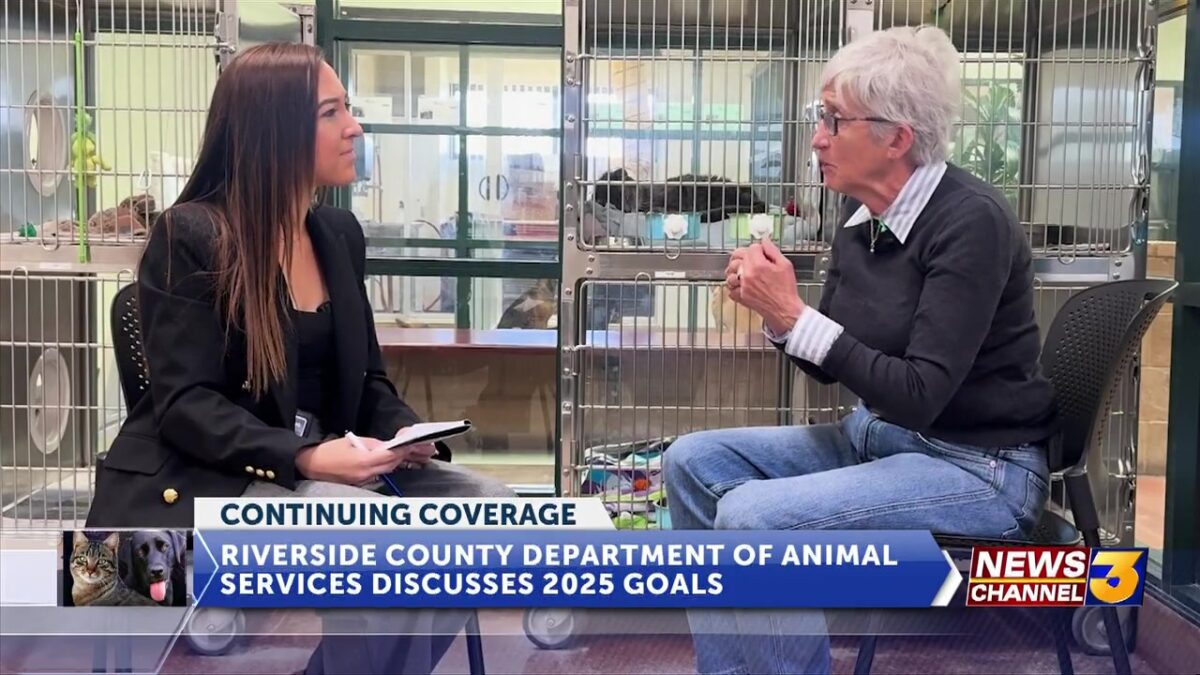Newly hired Director of Riverside County Department of Animal Services discusses shelter goals for 2025

Tori King
RIVERSIDE, Calif. (KESQ)– A new report found the euthanasia rate for the Riverside County Department of Animal Services dropped by 33%. Data shows in 2025, there have been 540 fewer animals euthanized this year compared to this same time period last year.
According to the Riverside County Department of Animal Services, a report on the progress from the first part of 2025 showed measurable gains in lifesaving, pet reunification, and adoption outcomes. Mary Martin, the newly hired director for the Riverside County Department of Animal Services, says the data in the Year-to-Date Highlights show the early impact of targeted, ongoing operational changes implemented in collaboration with Riverside County, Outcomes Consulting Group, RCDAS staff, volunteers, and community partners.
“I like a challenge,” said Martin. “There are a lot of improvements we can make day to day, but change takes time.” The new report showed the effects of the improvements being made in 2025 so far.
Positive Outcomes So Far This Year:
Live release rate increased to 80.9%, up from 72% during the same period last year
Euthanasia decreased by 33%, with 540 fewer animals euthanized
Adoption rate increased to 42%, up from 34% compared to same period last year
Transfer-out rates rose across both cats and dogs
The department says it is focused on removing barriers and increasing placement opportunities for animals through multiple ongoing operational improvements.
Key Operational Improvements:
Expanded public access by opening shelters on Sundays and extending hours on Wednesdays, making it easier for families to adopt or reclaim pets
Waived Return-to-Owner fees to remove financial barriers and help more lost pets return home
Increased the frequency of fee-waived adoption events, leading to faster placements and reduced length of stay
Completed cross-country pet transfer flights and enhanced partner rescue outreach, creating more adoption opportunities in partner regions and reducing local overcrowding
Enhanced marketing and visibility for adoptable animals through improved photography, promotion, and outreach
Martin just recently stepped into her new role this year, and has only been on the job for eight weeks. Martin was first introduced in March, and spoke with News Channel 3 about her decision to take on the role. As the shelter system continues to make substantial changes, Martin says she has a plan for the county’s shelters as she steers the department into the future.
News Channel 3’s Tori King spoke with Martin about the changes she has been able to make so far. “These results are a testament to the hard work of our staff and the strength of our community partnerships,” Martin said. “The team made real progress in just a few months, and we are committed to continuing this momentum to save more lives.”
RCDAS has been criticized for it’s euthanasia policies, namely in 2023 when the shelter system had the highest animal kill rate in the county. In 2024, the county’s overall live release rate was 71%, which lagged behind the Coachella Valley Animal Campus’s 80% rate.
“Hearing data like that feels like taking a bullet,” said Martin. “No one wants to see animals be euthanized at that rate. But I think the really important thing to focus on is not that the shelter is euthanizing that many animals. I mean we have to address it. But in order to fix it, we need to ask why the animals are coming to us in the first place. Why are animals losing their homes at the rate that they’re losing their homes?”
These rates have caused some local leaders and advocates to file a lawsuit against the county over shelter conditions.
“I can’t speak to the lawsuit itself, but what I can tell you is that we are laser focused on making sure that we’re doing all the things that we need to do for the animals in our care,” said Martin. “I think, once again, I keep coming back to this hiring of dozens of people, because I do think that the crew here want to do the right thing for animals, and just simply haven’t really been able to.”
Martin knows monumental efforts like this take a village.
“People here love animals,” said Martin. “I think we all agree that we love animals and don’t want to see them harmed. There is that laser focus on life saving so I think, there’s not enough people, and so greatness doesn’t shine through as much as it should. Because they’re so split in having to try to solve multiple problems at a time.”
To achieve no-kill status, shelter’s must hit a 90% release rate. And it’s something Martin has experience with after taking a Maricopa County shelter from 82% to 96% live release rates. But she says in order to make this a possibility in the future, the shelter needs more funding, and more employees.
Over the last two years, RCDAS had a budget of around $39,000,000 per year. When asked if that was enough money annually to make the shelter system eligible for no-kill status, Martin said no.
“If that were the budget and we weren’t going to get any additions, I would say probably not,”: siad Martin. “Given the amount of animals coming to us, it’s just not enough funding to get there. I believe the county is dedicated now to improving conditions in the shelters, not just for for the community, but for the people who work in the shelters too.” However, with more funding she says nothing is impossible.
“There’s no magic number,” explained Martin. “Do I believe it can happen one day? Yeah, I do. With the investment, with the community stepping up to help us. I don’t believe we can do it alone. Absolutely not.”